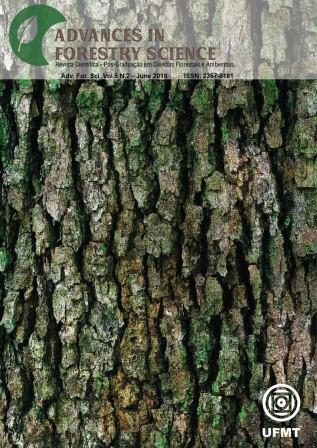Phytoosociology of floristic groups in subtropical seasonal forests in the south extreme of the Atlantic Forest Biome
DOI:
https://doi.org/10.34062/afs.v5i2.6134Abstract
This study aimed to differentiate the structure and flora of tree component groups of a stretch of forest at the southern end of the Atlantic Forest biome, Rio Grande do Sul. For sampling the tree layer (diameter at breast height ≥ 5.0 cm), 18 plots of 20 m × 10 m were systematically installed. Data were analyzed according to the structure and diversity of vegetation using the agglomerative hierarchical cluster analysis method with Ward linkage, and the quadratic Euclidean distance to measure dissimilarity. The formation of three groups of flora was evident. The species composition of each group belonged to different stages of natural succession. Group I had the highest species richness (42 species) and the highest species diversity (2.92 nats ind.-1). The species with the highest importance value index (IVI) were: in Group I, Actinostemon concolor (14.7%), Trichilia claussenii (VI = 9.8%), and Apuleia leiocarpa (8.9%); in Group II, Trichilia claussenii (21.2%), Sorocea bonplandii (18.1%), and Trichilia elegans (17.6%); and in Group III, Allophylus edulis (12.1%), Cupania vernalis (9.6%), and Trichilia claussenii (9.4%). The three groups showed a negative exponential diameter distribution, common in forests with auto-regeneration capacity.
Downloads
References
Almeida CM, Araujo MM, Longhi SJ, Rovedder AP, Sccoti MS, D’ávila MD, Aimi SC, Tonetto TS (2015) Análise de agrupamentos em remanescente de Floresta Estacional Decidual. Ciência Florestal, 25(3): 781-789. doi: 10.5902/1980509819682
Instituto Brasileiro de Geografia e Estatística (1990) Geografia do Brasil: Região Sul, Rio de Janeiro, 113p.
Poorter L, Bongers L, Bongers F (2006) Architecture of 54 moist-forest tree species: traits, trade-offs, and functional groups. Ecology, 87: 1289-1301. doi: 10.1890/0012-9658(2006)87[1289:AOMTST]2.0.CO;2
Holz S, Placci G, Quintana RD (2009) Effects of history of use on secondary forest regeneration in the Upper Parana Atlantic Forest (Misiones, Argentina). Forest Ecology and Management, 258(7): 1629-1642. doi: 10.1016/j.foreco.2009.07.023
Goebel PC, Palik BJ, Kirkman LK, Drew MB, West L, D. C. Pederson, “Forest ecosystems of a Lower Gulf Coastal Plain landscape: multifactor classification and analysis,” J. Torrey Bot. Soc, vol. 128, pp. 47–75, 2001. doi: 10.2307/3088659
Adel MN, Pourbabaei H, Dey DC (2014) Ecological species group - Environmental factors relationships in unharvested beech forests in the north of Iran. Ecologial Engineering, 69: 1-7. doi: 10.1016/j.ecoleng.2014.03.008
Queiroz JÁ, Trovão DBM, Oliveira AB, Oliveira ECS (2001) Análise da Estrutura Fitossociológica da Serra do Monte, Boqueirão, Paraíba. Revista de Biologia e Ciências da Terra, 6(2): 251-259.
Empresa Brasileira de Pesquisa Agropecuária (2009) Sistema brasileiro de classificação de solos, 3th. Brasília. 353p.
Alvares C, Stape JL, Sentelhas PC, Moraes GJL, Gerd S (2013) A.Köppen’s climate classification map for Brazil. Meteorologische Zeitschrift, 22(6): 711-728. doi: 10.1127/0941-2948/2013/0507
Schumacher MV, Longhi SJ, Brun EJ, Kilca RV (2011) A floresta estacional subtropical: caracterização e ecológica no rebordo do Planalto Meridional. Santa Maria: Pallotti, 320p.
Veloso HP, Rangel Filho ALR, Lima JC (1992) A Classificação de vegetação brasileira, adaptada a um Sistema Universal. Rio de Janeiro: Fundação IBGE. 123p
Itaqui J (2002) Quarta Colônia: Inventários técnicos flora e fauna. Santa Maria: Condesus. Quarta Colônia. 256p
APG III (2009) Angiosperm Phylogeny Group III. An update of the Angiosperm Phylogeny Group classification for the orders and families of flowering plants. Botanical Journal of the Linnean Society, 16: 105-121.
Kim J, Kohout FJ (2004) Statistical Package for The Social Sciences, SPSS® 13.0.
Budowski GN (1965) Distribution of tropical American rain forest species in the light of succession processes. Turrialba, 15(1): 40-42.
Vaccaro S, Longhi SJ, Brena DA (1999) Aspectos da composição florística e categorias sucessionais do estrato arbóreo de três Subseres de uma Floresta Estacional Decidual, no Município de Santa Tereza (RS). Ciência Florestal, 9(1): 1-18.
Felfili JM, Rezende RP (2003) Conceitos e métodos em fitossociologia. Comunicações Técnicas Florestais, 5(1): 68-73.
Callegaro RM, Araujo MM, Longhi SJ (2014) Fitossociologia de agrupamentos em Floresta Estacional Decidual no Parque Estadual Quarta Colônia, Agudo-RS. Agrária, 9: 590-598. doi:10.5039/agraria.v9i4a4853
Callegaro RM, Longhi SJ (2013) Grupos forísticos em uma Floresta Ombrófila Mista, Nova Prata, RS, Brasil. Revista Brasileira de Ciências Agrárias, 8(4): 641-647. doi:10.5039/agraria.v8i4a2877
Marcuzzo SB, Araujo MM, Longhi SJ (2013) Estrutura e relações ambientais de grupos florísticos em fragmento de Floresta Estacional Subtropical. Revista Árvore, 37(2): 275-287. doi: 10.1590/S0100-67622013000200009
Kilca KV, Longhi SJ (2011) A composição florística e a estrutura das florestas secundárias no rebordo do Planalto Meridional. In: Schumacher MV, Longhi SJ, Brun EJ, Kilca RV(ed) A Floresta Estacional Subtropical: caracterização e ecologia no rebordo do Planalto Meridional. Santa Maria: Pallotti. p.53-83.
Turchetto F, Callegaro RM, Conte B, Pertuzzatti A, Griebeler AM (2015) Estrutura de um fragmento de Floresta Estacional Decidual na região do alto-Uruguai, RS. Agrária, 10(2): 280-285. doi:10.5039/agraria.v10i2a4760
Lin LX, Cao M (2009) Edge effects on soil seed banks and understory vegetation in subtropical and tropical forests in Yunnan, SW China. Forest Ecology Management, 257: 1344–1352. doi: 10.1016/j.foreco.2008.12.004
Rasingam L, Parthasarathy N (2009) Diversity of understory plants in undisturbed and disturbed tropical lowland forests of Little Andaman Island, India. Biodiversity and Conservation, 18: 1045–1065. doi: 10.1007/s10531-008-9496-z
Royo AA, Carson WP (2006) On the formation of dense understory layers in forests worldwide: consequences and implications for forest dynamic, biodiversity, and succession. Canadian Journal of Forest Research, 36: 1345–1362. doi: 10.1139/x06-025
Imaña-Encinas J, Santana OA, Macedo LA, Paula JE (2008) Distribuição diamétrica de um trecho da Floresta Estacional Semidecidual na área do ecomuseu do cerrado. Revista Cerne, 14(1): 33-45.
Souza PB, Souza AL, Neto JAA (2012) Estrutura diamétrica dos estratos e grupos ecológicos de uma área de Floresta Estacional Semidecidual, em Dionísio, MG. Revista Árvore, 36(1): 1-12. doi: 10.1590/S0100-67622012000100016.
Durigan G (2012) Estrutura e diversidade de comunidades florestais. In: Martins SV (ed) Ecologia de florestas tropicais do Brasil. Viçosa: Editor UFV. p. 294-325.
Lorenzi H (1998) Árvores brasileiras: manual de identificação e cultivo de plantas arbóreas do Brasil. Nova Odessa: Plantarum. 352p.
Carvalho PER (2006) Espécies Arbóreas Brasileiras. Colombo: Embrapa Informação Tecnológica: Embrapa Florestas. 627p.
Downloads
Published
Issue
Section
License
All copyright must be assigned to the Federal University of Mato Grosso.

